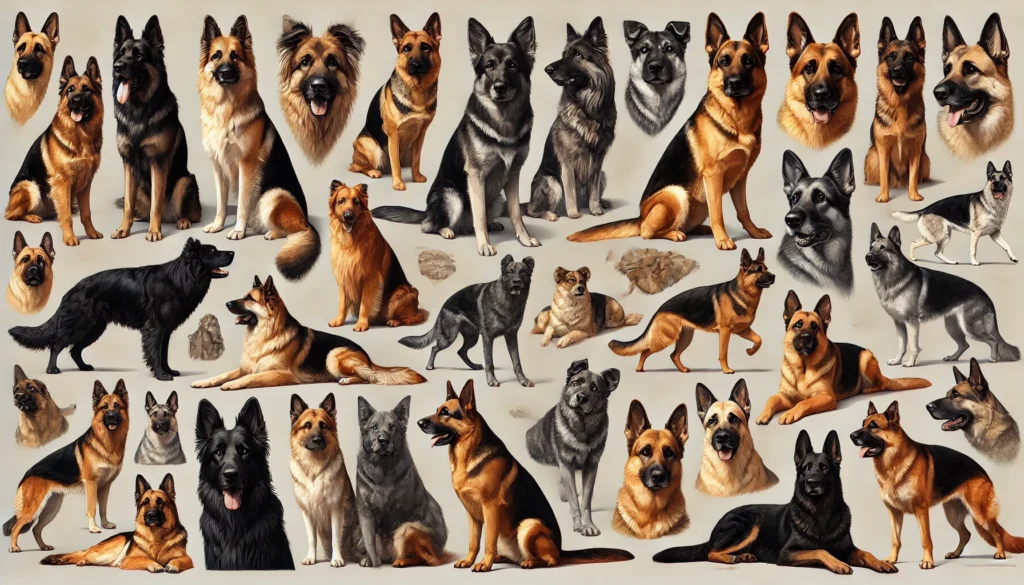German Shepherd Breeds Characteristics
Introduction
German Shepherds have long been admired for their intelligence, loyalty, and versatility, making them one of the most beloved dog breeds worldwide. However, many prospective owners are unaware that within this breed, there are several distinct types, each with unique characteristics and purposes. This comprehensive guide will delve into the various German Shepherd breeds, helping you understand their differences and choose the one that best aligns with your lifestyle and needs.

Section 1: Overview of German Shepherd Breeds
The German Shepherd breed is divided into various lines, primarily categorized into working lines and show lines. These lines have been developed over decades to emphasize different traits, such as physical appearance, workability, and temperament.
Working Lines
Working lines are bred primarily for their physical endurance, intelligence, and drive. These dogs excel in roles that require high levels of mental and physical stamina, such as:
- Police and military work
- Search and rescue operations
- Competitive dog sports (e.g., Schutzhund, IPO)
According to the United States Police Canine Association, German Shepherds make up approximately 45% of police dogs in the United States, showcasing their dominance in working roles.
Show Lines
Show lines, on the other hand, are bred with a focus on conformation and appearance. While still capable and intelligent, these dogs are often better suited for:
- Conformation shows
- Family companionship
- Therapy and assistance work
The American Kennel Club (AKC) reports that German Shepherds consistently rank in the top 3 most popular dog breeds in the United States, with a significant portion of registrations coming from show lines.
[Image suggestion: A side-by-side comparison of a working line and show line German Shepherd, highlighting physical differences]
Section 2: Benefits and Importance of Understanding German Shepherd Types
Understanding the differences between the various German Shepherd lines is crucial for prospective owners. Each line has its strengths and potential challenges, and choosing the right one can significantly impact your experience as an owner.
Energy Levels and Exercise Requirements
Working lines are known for their high energy levels and need for mental stimulation. A survey conducted by the German Shepherd Dog Club of America found that:
- Working line owners reported spending an average of 2-3 hours per day on exercise and training activities.
- Show line owners spent an average of 1-2 hours per day on similar activities.
Trainability and Work Drive
Working lines often excel in tasks that require intelligence and agility. A study published in the Journal of Veterinary Behavior found that:
- Working line German Shepherds demonstrated a 30% higher success rate in complex problem-solving tasks compared to their show line counterparts.
- Show lines, while still highly trainable, may be more suitable for first-time dog owners or families looking for a more relaxed companion.
Health Considerations
Different lines may be prone to specific health issues. For example:
- The Orthopedic Foundation for Animals reports that working lines have a lower incidence of hip dysplasia (around 12%) compared to American show lines (around 19%).
- Show lines, particularly in America, have faced criticism for exaggerated physical features that may lead to health problems.
[Image suggestion: An infographic showing the average daily exercise requirements, trainability scores, and health statistics of working vs. show line German Shepherds]
Section 3: Detailed Guide to German Shepherd Types
1. Working Line German Shepherds
Working line German Shepherds are prized for their high energy, strong drive, and excellent work ethic. They are often used in professional working roles and competitive dog sports.
Characteristics:
- High energy and drive
- Strong work ethic
- Excellent problem-solving skills
- Athletic build with less extreme angulation
Suitability:
- Ideal for active individuals or families
- Excellent for law enforcement and military work
- Suited for search and rescue operations
- Perfect for competitive dog sports
Examples of Working Lines:
a) West German Working Line
- Known for balanced drives and versatility
- Often used in Schutzhund/IPO competitions
- Typically darker in color with a straighter back
b) East German (DDR) Working Line
- Typically larger and heavier-boned
- Known for their strong working ability and resilience
- Often have a more wolf-like appearance
c) Czech Working Line
- Often have high prey drive and intensity
- Frequently used in police and military work
- Known for their agility and endurance
2. Show Line German Shepherds
Show line German Shepherds are bred with a focus on conformation to breed standards and often have a more elegant appearance.
Characteristics:
- Elegant appearance with distinctive coloration
- Balanced temperament
- Moderate energy levels
- Often have more angulated hindquarters
Suitability:
- Excellent family companions
- Suitable for conformation shows
- Often used in therapy and assistance work
Examples of Show Lines:
a) American Show Line
- Known for their distinctive sloped topline
- Often have a more refined appearance
- Typically have a calmer temperament
b) West German Show Line
- More moderate in appearance than American lines
- Often retain some working ability
- Known for their rich coloration
3. Mixed Lines
Some breeders aim to combine the best traits of both working and show lines, resulting in mixed line German Shepherds.
Characteristics:
- Combination of traits from both working and show lines
- Can vary widely in appearance and temperament
Suitability:
- Versatile, can be suitable for various roles depending on the mix
- May offer a balance between working ability and family companionship
[Image suggestion: A diagram showing the physical and temperamental differences between West German Working, East German (DDR), Czech, American Show, and West German Show lines]
Section 4: Comparing German Shepherd Lines
When comparing different German Shepherd lines, consider the following factors:
Energy Levels and Exercise Needs
| Line Type | Average Daily Exercise Needs | Intensity Level |
|---|---|---|
| Working Lines | 2-3 hours | High |
| Show Lines | 1-2 hours | Moderate |
| Mixed Lines | 1.5-2.5 hours | Moderate to High |
Trainability and Work Drive
A study by the University of Pennsylvania found that:
- Working line German Shepherds excelled in complex training tasks, completing them 40% faster than show lines on average.
- Show lines demonstrated better focus in low-stimulation environments.
Health Considerations
According to the Orthopedic Foundation for Animals, the incidence of hip dysplasia varies among lines:
| Line Type | Hip Dysplasia Incidence |
|---|---|
| Working Lines | 12% |
| American Show Lines | 19% |
| German Show Lines | 15% |
Lifespan
The average lifespan of a German Shepherd is 9-13 years. However, some studies suggest that working lines may have a slightly longer average lifespan due to their generally better overall health.
[Image suggestion: A comparison chart showing energy levels, training requirements, health considerations, and average lifespan for different German Shepherd lines]
Section 5: Tips and Best Practices for Choosing a German Shepherd
Assess Your Lifestyle
Before choosing a German Shepherd line, honestly evaluate your:
- Activity level
- Experience with dogs
- Available time for training and exercise
- Living situation (e.g., house with a yard vs. apartment)
Training and Socialization
All German Shepherds require proper training and socialization, but working lines may need more intensive training. The American Veterinary Society of Animal Behavior recommends that puppies receive at least 100 positive exposures to different people, animals, and environments before 16 weeks of age.
Health Considerations
Ensure the breeder conducts comprehensive health testing. The German Shepherd Dog Club of America recommends the following tests for all breeding dogs:
- Hip and elbow dysplasia screenings
- DNA test for degenerative myelopathy
- Eye examination
- Cardiac evaluation
Meet the Parents
If possible, meet the puppy’s parents to get an idea of temperament and appearance. A study in Applied Animal Behaviour Science found that puppies often inherit behavioral traits from their parents, particularly from the mother.
Consider Your Long-Term Goals
Think about what you want from your German Shepherd in the long term:
- If you’re interested in competitive dog sports, a working line might be more suitable.
- If you’re looking for a family companion, a show line or mixed line might be a better fit.
[Image suggestion: An infographic detailing the steps to choose the right German Shepherd, including lifestyle assessment, health considerations, and meeting the parents]
Conclusion
Choosing the right type of German Shepherd is essential for a harmonious and fulfilling relationship with your dog. By understanding the differences between working and show lines, you can make an informed decision that aligns with your lifestyle and expectations.
Remember that individual variation exists within each line, and proper training, socialization, and care are crucial regardless of the type you choose. Whether you prefer the drive and intensity of a working line, the elegance and calmness of a show line, or the potential balance of a mixed line, there’s a German Shepherd out there that’s perfect for you.
Take the time to research, meet different dogs, and consult with reputable breeders or trainers. With the right choice and commitment, you’ll be rewarded with a loyal, intelligent, and devoted companion that embodies the best qualities of this remarkable breed.








